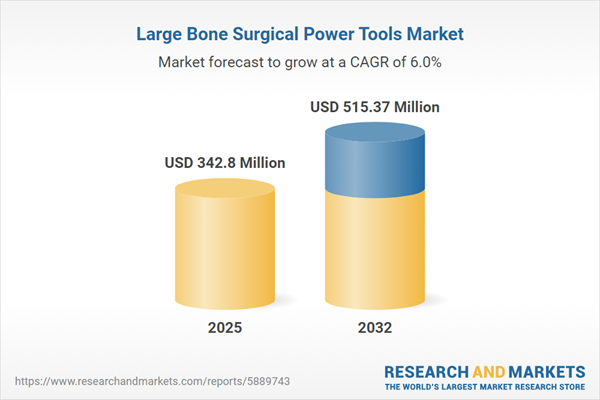Speak directly to the analyst to clarify any post sales queries you may have.
Senior decision-makers in orthopedics are navigating a rapidly transforming landscape defined by digital innovation, regulatory shifts, and evolving surgical practice standards. Success in the Large Bone Surgical Power Tools Market depends on aligning organizational strategy with these dynamic trends to foster operational responsiveness and advanced patient outcomes.
Market Snapshot: Large Bone Surgical Power Tools Market
The global Large Bone Surgical Power Tools Market is advancing steadily, with the current market value at USD 323.75 million. This sector is expected to surpass USD 342.80 million in 2025 and reach USD 515.37 million by 2032, representing a compound annual growth rate (CAGR) of 5.98%.
Key drivers include the push for heightened clinical precision and the widespread adoption of digital solutions within surgical settings. Manufacturers and providers are prioritizing innovations that enhance ergonomic function, expand device adaptability, and seamlessly connect tools across diverse healthcare environments. Product development continues to focus on supporting a broader array of procedures and integrating enhanced connectivity, all within a data-driven care delivery framework.Scope & Segmentation
This comprehensive market report is structured to empower senior leaders with practical intelligence for technology allocation and forward-thinking resource planning. The segmentation approach directly addresses product deployment, varied operational settings, and distinct business prospects to guide timely and effective decision-making.
- Application: Supports orthopedic needs for fracture repair, joint replacement, and spinal interventions. Applicable to both minimally invasive and conventional procedures for increased clinical versatility.
- Type: Includes oscillating, reciprocating, and sagittal saws. Each tool type serves established as well as progressive healthcare providers seeking specificity and adaptability in device use.
- Power Source: Encompasses battery-operated, electric, and pneumatic configurations that adapt to different workflow demands and facility infrastructure variances.
- End User: Designed for hospitals, ambulatory surgery centers, clinics, and outpatient facilities. Devices support efficient operations, procedural integrity, and regulatory compliance.
- Distribution Channel: Delivered via direct procurement, distributor networks, and digital platforms to maintain reliable, flexible supply chains and equipment accessibility.
- Region: Market dynamics are influenced by the Americas, Europe, Middle East & Africa, and Asia-Pacific. Each brings unique clinical requirements and adoption challenges shaped by local policies and health system structures.
- Companies Analyzed: Market strategy and innovation are highlighted through the activities of leaders including DePuy Synthes, Stryker, Zimmer Biomet, Medtronic, Smith & Nephew, CONMED, NuVasive, Exactech, Globus Medical, and B. Braun Melsungen.
Key Takeaways for Senior Decision-Makers
- Digital innovations are streamlining surgical workflows, enhancing data sharing, and promoting more unified and reliable patient care processes in operating rooms.
- Focus on device ergonomics and advanced safety features is supporting staff well-being and helping organizations meet their quality and risk management objectives.
- Seamless interoperability with imaging systems and electronic health records is enabling improved documentation and adaptive patient management in real time.
- Growth in outpatient and less invasive procedures is driving the need for portable and easily maintained systems that can support multiple care settings efficiently.
- Collaborative efforts among manufacturers, clinicians, and regulatory bodies are ensuring that device enhancements meet evolving procedure and safety requirements, maintaining alignment with compliance goals.
- Strategic procurement practices are reinforcing inventory resilience, making it easier for organizations to manage supplier disruptions and ensure continuous access to critical tools.
Tariff Impact: Navigating Regulatory Change
Recent tariff changes in the United States are prompting manufacturers in the Large Bone Surgical Power Tools Market to increase sourcing flexibility and build stronger supplier relationships. Healthcare organizations are responding by broadening local procurement channels and vendor partnerships, which helps safeguard equipment access and cushion operational budgets from pricing pressures. Enhanced oversight is further supporting compliance needs and overall risk management.
Methodology & Data Sources
The findings in this report are underpinned by a rigorous triangulation method, which integrates insights from orthopedic surgeons, senior health system leaders, regulatory sources, and technical documentation. This approach ensures that the analysis reflects the requirements and realities of B2B healthcare stakeholders.
Why This Report Matters
- Facilitates strategic benchmarking and market planning, empowering leadership teams to prioritize surgical technology investments aligned with clinical and business goals.
- Highlights new pathways for growth and operational risks, supporting segmentation and resource allocation that maximize organizational return and resilience.
- Strengthens procurement and supply chain practices, helping maintain stable device availability despite evolving regulations or market dynamics.
Conclusion
Senior orthopedics executives who embrace proactive technology planning, regulatory responsiveness, and supplier collaboration will reinforce care standards and bolster their position in the Large Bone Surgical Power Tools Market.
Additional Product Information:
- Purchase of this report includes 1 year online access with quarterly updates.
- This report can be updated on request. Please contact our Customer Experience team using the Ask a Question widget on our website.
Table of Contents
3. Executive Summary
4. Market Overview
7. Cumulative Impact of Artificial Intelligence 2025
Companies Mentioned
The companies profiled in this Large Bone Surgical Power Tools market report include:- DePuy Synthes, Inc.
- Stryker Corporation
- Zimmer Biomet Holdings, Inc.
- Medtronic PLC
- Smith & Nephew PLC
- CONMED Corporation
- NuVasive, Inc.
- Exactech, Inc.
- Globus Medical, Inc.
- B. Braun Melsungen AG
Table Information
| Report Attribute | Details |
|---|---|
| No. of Pages | 188 |
| Published | November 2025 |
| Forecast Period | 2025 - 2032 |
| Estimated Market Value ( USD | $ 342.8 Million |
| Forecasted Market Value ( USD | $ 515.37 Million |
| Compound Annual Growth Rate | 5.9% |
| Regions Covered | Global |
| No. of Companies Mentioned | 11 |









